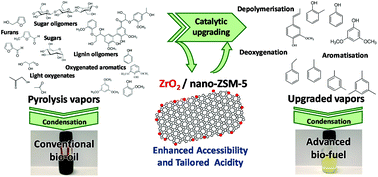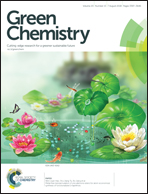Engineering the acidity and accessibility of the zeolite ZSM-5 for efficient bio-oil upgrading in catalytic pyrolysis of lignocellulose†
Abstract
The properties of the zeolite ZSM-5 have been optimised for the production and deoxygenation of the bio-oil* (bio-oil on water-free basis) fraction by lignocellulose catalytic pyrolysis. Two ZSM-5 supports possessing high mesopore/external surface area, and therefore enhanced accessibility, have been employed to promote the conversion of the bulky compounds formed in the primary cracking of lignocellulose. These supports are a nanocrystalline material (n-ZSM-5) and a hierarchical sample (h-ZSM-5) of different Si/Al ratios and acid site concentrations. Acidic features of both zeolites have been modified and adjusted by incorporation of ZrO2, which has a significant effect on the concentration and distribution of both Brønsted and Lewis acid sites. These materials have been tested in the catalytic pyrolysis of acid-washed wheat straw (WS-ac) using a two-step (thermal/catalytic) reaction system at different catalyst/biomass ratios. The results obtained have been assessed in terms of oxygen content, energy yield and composition of the produced bio-oil*, taking also into account the selectivity towards the different deoxygenation pathways. The ZrO2/n-ZSM-5 sample showed remarkable performance in the biomass catalytic pyrolysis, as a result of the appropriate combination of accessibility and acidic properties. In particular, modification of the zeolitic support acidity by incorporation of highly dispersed ZrO2 effectively decreased the extent of secondary reactions, such as severe cracking and coke formation, as well as promoted the conversion of the oligomers formed initially by lignocellulose pyrolysis, thus sharply decreasing the proportion of the components not detected by GC-MS in the upgraded bio-oil*.



 Please wait while we load your content...
Please wait while we load your content...